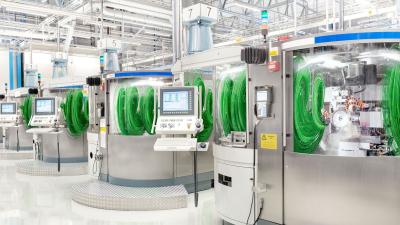
Castrol offers Castrol Hysol SL 35 XBB and Castrol Alusol SL 51 XBB. Created to support the manufacturing of metal components, Castrol’s cutting fluid technology maintains constant pH levels (9-9.5) and stable conditions for longer than other standard cutting fluids, according to the company. This reduces the need to add expensive treatment additives and biocides, as well as safeguarding against costly uncontrolled system changes. Castrol’s Hysol and Alusol XBB products do not rely on the use of boron or formaldehyde releasing agents or additional biocide and fungicide additive packs, but are still able to meet and exceed the lifetime expectations of the benchmark technology to date. In many cases, customers have been able to significantly reduce or completely eliminate the use of biocides from their management processes.
Cutting fluids perform an essential role in the manufacturing of many types of metal components. One of the main drawbacks of the traditional technology is that, over time, the fluid can suffer from bacterial growth and contamination resulting in the fluid "going off." This leads to pH depletion, unpleasant odors, unstable emulsion and poor performance. From a breakthrough achieved by Castrol’s liquid engineering, these new Hysol and Alusol XBB products redefine the properties of cutting fluids, and they are resistant to acid attack from bacteria, proven to maintain pH at a constant level and are, therefore, inherently more resistant to bacterial growth.
Dr. Rudi Janner, Castrol Global Product Manager for Cutting Fluids, said: “Our liquid engineers have reinvented the fundamentals of cutting fluid technology. By having greater control of the pH, the reliance upon short-lived biocides to control bacteria is significantly reduced or eliminated. This ultimately translates into significant improvements for controlling manufacturing costs, increasing productivity, protecting the quality of end products and meeting HSSE requirements.”
As the lifetime of the cutting fluid is increased, costs associated with disposal of spent fluid are reduced and system stability minimizes the requirement for costly maintenance regimes. Even at low concentrations, Castrol Hysol and Alusol XBB products maintain machining performance and can help to protect against corrosion and staining. The lubricating properties help prevent swarf build up, assuring high-quality surface finishes and low scrappage rates.
For use with ferrous alloys, Castrol Hysol SL 35 XBB is proven to maintain system performance and fluid life. It neutralises up to 24% more acidic material than standard cutting fluids and reduces overall fluid top-up volumes by up to 45%. Castrol Alusol SL 51 XBB improves precision performance in aluminum machining. It neutralizes up to 33% more acidic material than standard aluminium cutting fluids and reduces overall fluid top-up volumes by up to 30% while ensuring cutting precision. Both products reoptimise the fluid in use and significantly reduce or can eliminate the need for biocide additives.
Castrol’s new cutting fluid technology also underpins products that positively impact an organisation’s HSE profile by significantly improving the factory environment and working conditions. By maintaining system stability, the unpleasant odours produced by an emulsion that is suffering from a large population of bacteria are minimised and the reduced need for testing pH levels reduces potential skin complaints for workers. Furthermore, the reduced need for biocide additives minimizes the need for workers to handle dangerous chemicals.
Contact Details
Related Glossary Terms
- alloys
alloys
Substances having metallic properties and being composed of two or more chemical elements of which at least one is a metal.
- cutting fluid
cutting fluid
Liquid used to improve workpiece machinability, enhance tool life, flush out chips and machining debris, and cool the workpiece and tool. Three basic types are: straight oils; soluble oils, which emulsify in water; and synthetic fluids, which are water-based chemical solutions having no oil. See coolant; semisynthetic cutting fluid; soluble-oil cutting fluid; synthetic cutting fluid.
- emulsion
emulsion
Suspension of one liquid in another, such as oil in water.
- fungicide
fungicide
Additive to cutting fluids to inhibit fungi. See bactericide.
- swarf
swarf
Metal fines and grinding wheel particles generated during grinding.

